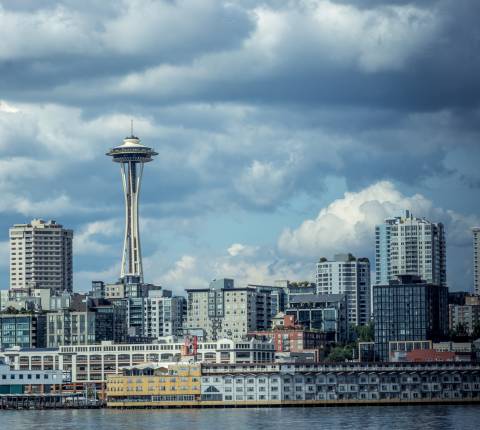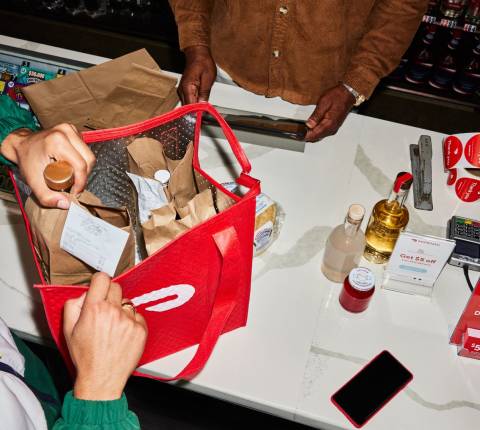Imagine you’re a restaurateur. You’re an expert in crafting the ideal dish with fresh ingredients, balanced flavors, perfect textures. You’re juggling your back-of-house team, your front-of-house team. You’re a professional.
Now imagine you’re managing an in-house delivery team. An order comes in. You confirm and start your prep. You’re just about to hand it off to a delivery person when another order comes in. It’s in the same part of town. Should you tell the driver to wait while you prepare the second order, so that they can deliver both at once — meaning the first order will likely be late and cold — or send them off with just the first delivery, knowing they likely won’t be back in time for the second delivery? Maybe you should’ve hired more delivery workers — but what if you don’t get enough orders to justify a larger team?
This thought exercise can help us understand why less than a quarter of independent merchants surveyed in 2023 currently offer delivery powered by their own drivers. In explaining why, 40% said that demand for deliveries can be unpredictable and 20% said that it is too difficult to manage shifts. Just over half said that it does not make financial sense for their business to employ in-house delivery drivers.
DoorDash provides tools to help operators better understand customer ordering patterns. However, even with helpful data, some unpredictability will remain. Fluctuations in demand for delivery mean that merchants cannot perfectly foresee the number of orders for a given week, day, or hour. The vast majority (88% in 2022) of DoorDash orders are unscheduled, meaning they are for immediate delivery. A better understanding of the unpredictability of orders for merchants offers even more insight into why on-demand delivery through third-party platforms appeals to many merchants.
Just how unpredictable are orders really for a typical merchant? We explored the set of US restaurants who solely used DoorDash to power off-premises delivery in early 2023 to learn more. These merchants range from small restaurants with a single location to medium-sized chains with several dozen. This way, we could be sure we were capturing all of a merchant’s third-party platform orders, not just a subset.
To begin, we looked at week-to-week variability. Barring holidays or special events, merchants might rationally plan schedules for their delivery teams a week at a time, based on the previous week’s orders. Of course, merchants can know some days of the week are busier than others, so we’d want to compare the same day of the week. Below, we compare two consecutive Fridays, focusing on merchants with at most 50 orders each Friday for simplicity (this represents 84% of this sample).

What we see is that orders are variable from one Friday to the next. For example, among merchants with roughly 20 orders on one Friday (shown in red), orders the following Friday ranged from 5 to 42—that is, from roughly a quarter of the previous week’s orders to more than double. Across the sample, nearly half (45%) of merchants saw either an increase or a decrease of at least 25% from the first week to the second, and only 6% had the exact same number of orders in both weeks.
This unpredictability makes planning not only challenging, but costly. Scheduling too few delivery workers can mean late deliveries, or having to turn down orders; scheduling too many delivery workers can mean paying workers to be idle.
We still haven’t explored the timing of orders within a day. For simplicity, we look at a single restaurant on ten consecutive Fridays, and count the number of orders received during each hour. The graphic below cycles through each of these ten Fridays. While there are some general patterns—for example, the dinner hours are generally busier than mid-afternoon—there are many exceptions.

For example, one Friday there are as many as fourteen orders during the 6 p.m. hour, while another there are only four. How many delivery workers should this merchant schedule during this hour? Too few, and orders will be late—too many, and the merchant risks paying staff to sit around doing nothing.
While some merchants are able to take some of the guesswork out by analyzing their own data, many don’t have the bandwidth for this. DoorDash can help with this too: while we can never predict the future, our Merchant Portal can help restaurateurs understand general patterns in where their customers are, what they are ordering, and when they are ordering. It also offers tools for menu optimization, managing customer feedback, and improving operations quality.
Even the best tools, however, cannot remove all uncertainty. DoorDash can help mitigate the remaining unpredictability, so that restaurateurs and merchants should focus on what they do best—serving their customers and providing a high quality experience—and leave the logistics and multi-sided optimization problems to us, if they choose.



